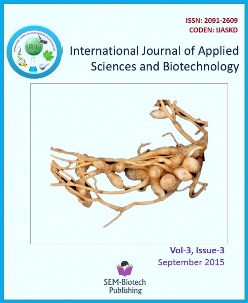A Comparative Study of Bioethanol Production from Aquatic Weeds
DOI:
https://doi.org/10.3126/ijasbt.v3i3.13190Keywords:
bioethanol, aquatic weeds, yeast, hydrolysisAbstract
A greatest challenge for society in the 21st century is to meet energy demand, where biomass is subjected for pre-treatment and converted into biofuel (alcohol). Aquatic weeds are potential bio resources which are easily available for biofuel production. Aquatic weeds like Alternanthera sessilis, Typha latifolia, Eichhornia crassipes, Baccopa monnieri, Ipomoea aquatica and Pistia stratiotes are estimated for carbohydrates content. Highest content of reducing sugar was observed in Alternanthera sessilis (296.8µg/ml), total sugar in Ipomoea aquatic (880.00mg/ml), starch in Alternanthera sessilis (57.13mg/ml), cellulose in Pistia stratiotes and Typha latifolia (280.00mg/ml), hemicellulose in Typha latifolia (26.85mg/ml); high cellulosic aquatic weeds were subjected to pre-treatment methods like physical, chemical and enzymatic method.
Meanwhile different yeast strains from the fruits of Manilkara zapota, Cucumis melo, Musa paradisiaca, Citrullus lanatus, Punica granatum and Ananas comosus were isolated yeast of Citrullus lanatus shows highest amount of alcohol production (307µg/ml), which is inoculated to pre-treated hydrolysate, where Alternanthera sessilis and Typha latifolia shows high amount of alcohol in physical method (160.5 and 115.4µg/ml). In chemical method in acid hydrolysis it shows 387.1 and 69.63µg/ml and in alkali hydrolysis 62 and 170µg/ml, so these two weeds were taken for enzymatic method for alcohol production, on seventh day Alternanthera sessilis shows highest alcohol production (113.33µg/ml), hence among six weeds Alternanthera sessilis and the yeast of Citrullus lanatus produces more amount of alcohol than others and it also shows that enzymatic method of pre-treatment is best in hydrolysis of biomass than physical and chemical method. The study revealed the possibility of producing alcohol from locally available fruits using simple, cheap and adaptable technology with biochemically characterized yeast strains.
Int J Appl Sci Biotechnol, Vol 3(3): 446-451




